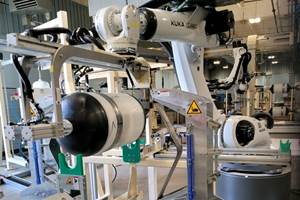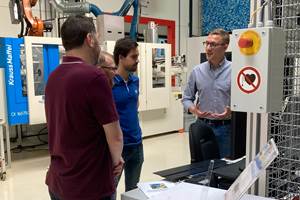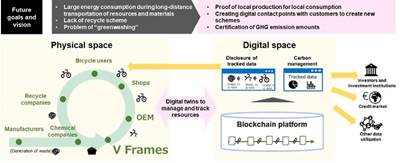Chemnitz University of Technology receives €6 million to expand research into "green" carbon fiber
Carbon LabFactory and InnoCarbEnergy project conduct R&D across entire value chain from raw materials through processes to structures and systems on a pilot line with technology demonstrators.
The MERGE research cluster, Carbon LabFactory and CarbonInnoEnergy projects are led by Prof. Dr. Lothar Kroll (right). Photo Credit: Chemnitz University of Technology and Hendrik Schmidt
Chemnitz University of Technology (Germany) is taking a global leadership role in researching “green” carbon fibers and developing a value chain for carbon materials. The university received a grant of €5.87 million from the German Federal Office for Economic Affairs and Export Control (BAFA) for establishing and expanding the Carbon LabFactory.
The funds are provided by the Federal Ministry for Economic Affairs and Climate Action (BMWK) as part of the program “Strengthening the Transformation Dynamics and Awakening in the Coal-Mining Region and at Coal-Fired Power Plant Locations” (STARK), which supports the transformation process to an innovative economic structure in coal-mining regions.
The project is based at the Professorship of Lightweight Structures/Polymer Technology, headed by Prof. Dr. Lothar Kroll at Chemnitz University of Technology. The Fraunhofer Institute for Applied Polymer Research (IAP, Potsdam, Germany) is also involved.
The entire value chain, from raw material extraction and processing, through materials and processes, to structures and systems on a pilot line scale, is being researched as part of the Carbon LabFactory and theInnoCarbEnergy project.
“Comparable pilot plants are currently only in operation in Victoria, Australia and North Carolina in the U.S. … a research center for ‘green,’ cost-effective, tailor-made and sustainable carbon fibers is being created that is unique in Europe.”
MERGE R&D cluster and InnoCarbEnergy
The MERGE research cluster includes Chemnitz University of Technology, Fraunhofer IAP and other research institutions from Saxony and Brandenburg. It is located at a traditionally coal-fired power plant in Boxberg/Upper Lusatia.
This site is significant, as German government climate policy commits to the complete phase-out of coal-fired power generation, which will bring a paradigm shift in the area’s economy.
“This will put the Free State of Saxony in the global top league in carbon fiber research,” said Thomas Schmidt, Saxon senate minister for regional development during the 2021 ceremony to establish MERGE and the InnoCarbEnergy project. “Comparable pilot plants are currently only in operation in Victoria, Australia and North Carolina in the U.S. I am delighted for Lusatia and the community of Boxberg that another step is now possible on the road to the carbon fiber lightweight construction of the future. The development of application-oriented research is crucial for the future of jobs in Lusatia. In Boxberg, a research center for “green,” cost-effective, tailor-made and sustainable carbon fibers is being created that is unique in Europe.”
“However, since their use is dominated by high costs, a petrochemical basis and a discrete range of properties, the growth scenario of carbon fiber lightweight construction in large series only occurs if the potential for cost reduction is optimally exploited, tailor-made properties dominate compared to a rigid portfolio and the CO2 footprint is massively reduced.”
Green carbon fiber key for sustainable lightweight construction
“Green” carbon fibers are based on renewable raw materials and renewable energies. Technical textiles made from high-performance carbon fiber are currently experiencing a renaissance as reinforcement materials for highly stressed structural components. Carbon fiber-reinforced polymer (CFRP) composites are among the materials of the future. CFRP components already achieve weight savings of up to 50% compared to comparable aluminum and steel components. Thus, demand and production capacities for carbon fiber continue to increase worldwide.
"However, since their use is dominated by high costs, a petrochemical basis and a discrete range of properties, the growth scenario of carbon fiber lightweight construction in large series only occurs if the potential for cost reduction is optimally exploited, tailor-made properties dominate compared to a rigid portfolio and the CO2 footprint is massively reduced,” says Kroll, as head of the MERGE research cluster at Chemnitz University of Technology.
Carbon LabFactory
The Carbon LabFactory was officially endorsed in June 2021 by the regional government of Lusatia, the state of Saxony and the German ministries outlined above. The research team led by Prof. Dr. Lothar Kroll is now working with the Saxon government on the design of the research site. Funds of roughly €60 million have been budgeted to establish the Carbon LabFactory by 2026.
The Carbon LabFactory, as a branch of Chemnitz University of Technology in Boxberg/Upper Lusatia, sees itself as a nucleus for the settlement of companies in Lusatia in order to sustainably shape the climate-friendly transformation of the region from the coal economy to a self-supporting bio-economy on the basis of future-oriented lightweight construction technologies.
The mayor of Boxberg, Achim Junker, who supports the project extensively, is also pleased about this prospect and the construction of a new pilot plant for the production of “green” carbon fibers in his region. Comparable pilot plants are currently only available at the Oak Ridge National Lab (ORNL, Knoxville, Tenn., U.S.).
The project team, led by Kroll, has set itself the goal of exploring new avenues for lightweight structures and products of the future, as well as developing downstream processes to market maturity in accompanying collaborations and projects.
Professor Kroll's team has extensive results on the potential of carbon fibers in numerous industries, innovative solutions for “green” carbon fibers and further process routes. “In the coming years, scientists will continue to research the entire value chain — from the molecule to the carbon fiber, textile semi-finished products and preforms to high-performance components and systems under industrial conditions — and transfer it into practice,” says Kroll.
“With this project, we are not only making an important contribution with potential for the transformation process in Lusatia, but above all for technological progress in global climate protection,” says Kroll. “Chemnitz University of Technology is establishing a new and unique field of research … this facility will not only conduct carbon fiber research, but also develop and test downstream textile and plastics processing processes on a pilot line scale.” These methods will be tested using technology demonstrators.
“We must succeed in mastering this complex and new technology on a pilot scale, then we can also successfully transfer the technology to industry,” adds Dr. Mario Naumann, research project associate.
For further information, please contact Prof. Dr. Lothar Kroll, head of the SLK Professorship, tel. 0371 531-13910, e-mail slk@mb.tu-chemnitz.de, and Dr. Mario Naumann, research associate at the SLK Professorship, tel. 0371 531-38758, e-mail mario.naumann@mb.tu-chemnitz.de.
Related Content
Automated filament winding system increases throughput, reduces manual labor for pressurized well tank production
For its new line of composite well water tanks, Amtrol worked with Roth Composite Machinery on an automated process for faster, more easily tracked production.
Read MoreSustainability has come to composites and it's here to stay
It might be tempting to think of sustainability as a buzzword, but there are structural changes taking place in the composites industry that signal its permanence.
Read MoreWomen in the Composites Industry brings together women for networking, educational opportunities
Aiming to support the growth of women in this industry, the WCI industry group and its partners recently held its first live training event hosted by Owens Corning.
Read MoreTPRC training courses target thermoplastic composites
Three upcoming in-person thermoplastic composites courses, ranging from entry-level to advanced, are organized to enhance composites professionals’ knowledge in this burgeoning field.
Read MoreRead Next
The state of recycled carbon fiber
As the need for carbon fiber rises, can recycling fill the gap?
Read MoreFujitsu, Teijin start joint trials to promote value of recycled carbon fiber
Three-month trials with German bicycle manufacturers will lead to new platform implementation to promote use of recycled materials, enable emissions tracing/management.
Read MoreComposites end markets: Energy (2024)
Composites are used widely in oil/gas, wind and other renewable energy applications. Despite market challenges, growth potential and innovation for composites continue.
Read More




























